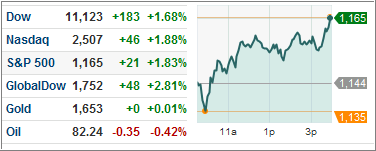For the third consecutive trading session, markets remained in the green, giving some hope for equities. Once again, major indices and commodities rose with the S&P 500 gaining 1.83%, while the U.S. dollar slightly depreciated to $1.34/euro.
Today’s gains were possibly in part due to strong September sales figures from major U.S. retailers that exceeded expectations, suggesting a potential rebound in consumer spending to lift the economy. Furthermore, talks of European bank aid propelled markets into positive territory.
However, this short-term optimism seems premature especially ahead of Friday’s jobs numbers. Plus, Europe’s uncertain long-term plan on how to deal with mounting debt is worrisome, especially with Germany’s insistence on banks trying to fix their own balance sheets and for European investors to bear more of the burden in the case of a Greek bailout.
At this time, I see no reason to jump back into equities. The position of our Trend Tracking Indexes support that view.
Even Standard & Poor’s sees more downside action ahead as reported by ETF Trends:
The recent decline in the S&P 500 to a new 52-week low looks to be a “false break,” after which decent rallies often follow, according to Standard & Poor’s U.S. Investment Policy Committee.
“Market sentiment turned quite bearish over the past week, a potential positive for at least the near term. In particular, bullish sentiment on the Investor’s Intelligence poll fell to 34.4% this week while bearish sentiment rose to 45.2%,” it said.
“This is the largest spread favoring the bears since March 2009,” the S&P committee noted. Stocks hit bottom that month after the global credit meltdown.
…
“Even though the market could chug higher in the near- to intermediate-term, we still see the S&P 500 dropping into bear market territory either later this year or during the first part of 2012,” S&P forecast.
[Emphasis added]The overall global economic picture hasn’t changed especially on the European front. News of the ECB extending 12-13 month loans to banks and developing a bank recapitalization plan, as well as a bond purchasing program to boost lending, has provided some temporary relief for markets.
However, the European Banking Authority announced that European banks in total might have a capital deficiency of up to $200 billion despite a series of recent stress tests showing few red flags. This is a major cause for concern that should keep contagion fears alive.
With unemployment numbers coming out tomorrow, we should gain a clearer picture on the U.S. economic situation and if this 3-day rebound will have legs or will fade into oblivion.
Contact Ulli
